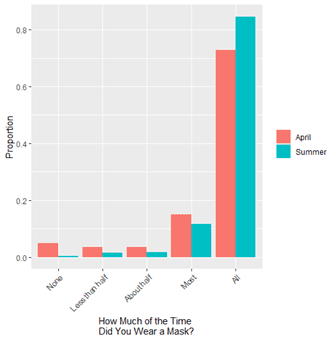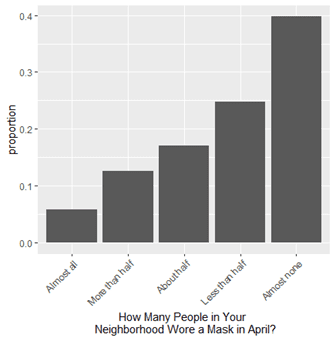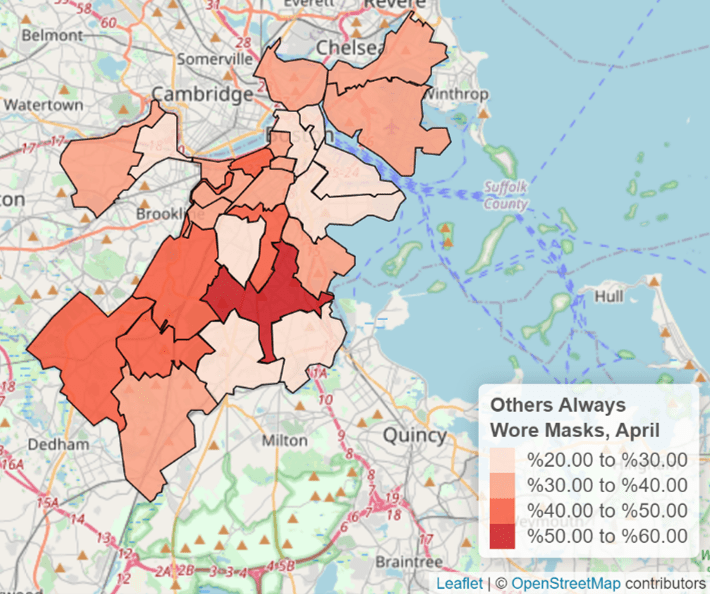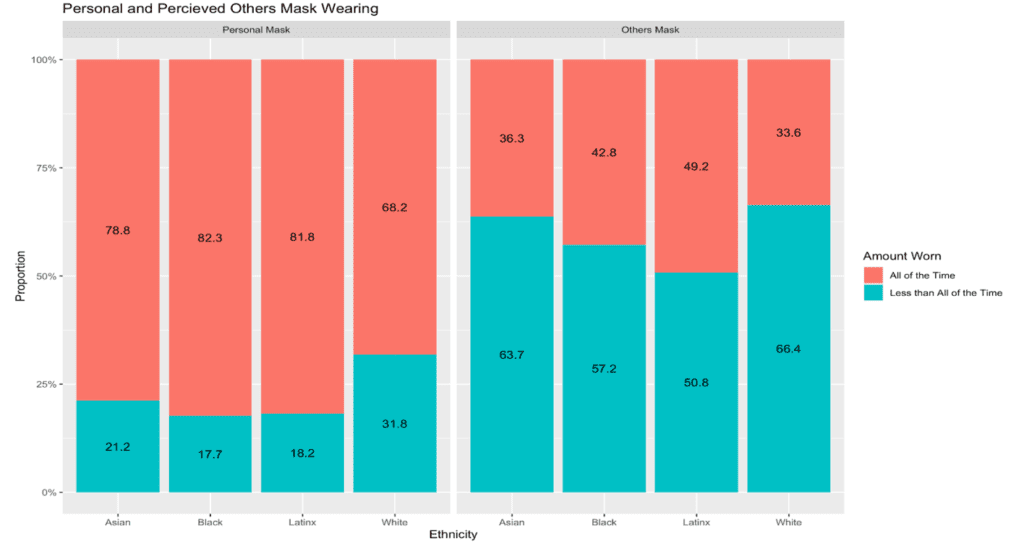In our second report drawn from the Living in Boston During COVID survey, we have focused on contrasting themes of fear and ambivalence among Bostonians. On the one hand, there appears to be broad consensus that the virus is dangerous, that social distancing guidelines are important, about wearing masks and avoiding high-risk activities, and that asymptomatic spread is a concern. However, the proportion of respondents who differed on these views is non-trivial and varies substantially by neighborhood, race, and income. These variations can help us to understand the vulnerabilities that different communities face as cases surge this winter. In today’s data story, the third of four from this report, we focus on mask wearing.
Wearing masks has been noted as one of the simplest and most effective for curtailing the spread of COVID-19. First, the good news. Nearly 75% of people said they always wore a mask in April, and this rose to 85% in the Summer. This near unanimous attitude among our respondents, however, appears to mask—pun likely intended—a more ambivalent reality. Although most people claimed that they always wore a mask in April, only 40% said that “almost all” people in their neighborhood did. We see these distinctions clearly in Figure 1.


Figure 1. Frequency of wearing masks in April and Summer (left panel), and proportion of neighbors wearing masks in April (right panel).
If we look at this distribution geographically in Figure 2, we see that respondents from the southern urban core, especially parts of Roxbury and Central Dorchester (e.g., Codman Square, Franklin Field), were most likely to report wearing masks themselves and that their neighbors did the same—except for central Roxbury (e.g., Dudley Square), where respondents reported low levels of mask-wearing by neighbors. East Boston also tended to have higher levels of mask-wearing on both measures. On the other end of the spectrum, neighborhoods on the east coast reported the lowest levels of mask-wearing, especially when respondents described their neighbors. Notably, these were the same neighborhoods highlighted in the data stories from the last two days that had the lowest perception of risk, lowest endorsement of social distancing guidelines, and highest risk behaviors.


Figure 2. Proportion of people who said that they always wore a mask in public (right panel) and (b) said that their neighbors all wore masks in public (left panel) in April, by neighborhood.
Meanwhile, most other neighborhoods fell somewhere in between. The potential explanations for this are varied. It could be a function of perceptions of risk and attitudes toward guidelines in these communities, as these were the same communities that fell in the middle on those other measures. Alternatively, there may be other local dynamics. For example, those living in neighborhoods like Jamaica Plain or West Roxbury may have more space in their neighborhoods where they feel comfortable taking a walk without a mask because they can maintain safe social distance, which is not necessarily the case in the more densely populated areas of the city. This would also be consistent with the finding in the first report that people in these neighborhoods spent more time exercising or walking outdoors.
The distribution of mask wearing—either by oneself or by others—appears to be better understood geographically than demographically. We did see modest differences across races (see Figure 3), particularly with fewer White respondents indicating that they and their neighbors wore masks all the time. We also saw a similar tendency among higher income residents. But these trends on their own are not easily interpretable and will need to be examined more thoroughly. In any case, it is important to keep in mind that even a small number of individuals choosing not to wear masks can have a broader impact on transmission in a community.

For the third consecutive data story, we reemphasize two main themes from the second report on the Living in Boston During COVID survey. First, there is a seeming consensus about the pandemic and how to properly navigate it—but there is still enough dissension from this consensus to create vulnerabilities for communities. Second, the form that these vulnerabilities take will be critical to how policymakers and practitioners support communities during the second wave. We again see that certain more affluent, majority-White neighborhoods on the east coast of the city have more residents deviating from guidelines. But that summary ignores the question about whether others in the neighborhoods were wearing masks. The distribution of that question suggests that nearly all communities have some work to do. Again, these insights can support targeted messaging and education that will be a crucial component of counteracting the second wave of the pandemic.
The content of this post is drawn from the Living in Boston during COVID survey conducted by the Boston Area Research Initiative, the Center for Survey Research at UMass Boston, and the Boston Public Health Commission. It was funded by the National Science Foundation’s Human-Environment and Geographical Sciences (HEGS) program through a grant for rapid-response research (RAPID; Award #2032384). The results presented here were part of a longer report on “Inequities in Navigating a Pandemic”.

